 W
WBear Dance is a Native American ceremonial dance that occurs in the spring. It is a ten-day event to strengthen social ties within the community, encourage courtship, and mark the end of puberty for girls.
 W
WThe Booger Dance is a traditional dance of the Cherokee tribe, performed with ritual masks. It is performed at night-time around a campfire, usually in late fall or winter.
 W
WThe Buffalo Dance, or Bison Dance, is an annual dance festival of many North American Plains Indians, including the Mandan, Sioux, Cheyenne, Pawnee, and Omaha, among others. The festival traditionally coincided with the return of the buffalo herds, and included a feast and a dance with a number of men wearing buffalo and other animal skins.
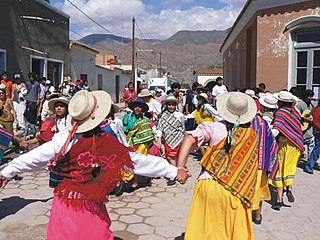 W
WThe Carnavalito is a traditional South American dance from the Bolivian Altiplano and puna regions of Peru that is practiced in relation to religious festivities. The current form of the dance is an expression of syncretism between indigenous and Spanish colonial culture.
 W
WCh'unchu is a folk dance in Peru. It is performed on festivals of the Cusco Region like Mamacha Carmen in Paucartambo and Quyllur Rit'i. Varieties include q'ara ch'unchu, qhapaq ch'unchu and wayri ch'unchu. Its name comes from a derogatory Quechua word for native inhabitants of the Amazon Rainforest.
 W
WThe Concheros dance, also known as the Chichimecas, Aztecas and Mexicas, is an important traditional dance and ceremony which has been performed in Mexico since early in the colonial period. It presents syncretic features both pre-Hispanic and Christian. The dance has strong visual markers of its pre-Hispanic roots with feathered regalia, indigenous dance steps and indigenous instruments such as drums. However, the name Concheros comes from a type of lute made with an armadillo shell, showing Spanish influence. The dance in its current form was the adaptation of the old “mitote” dance to Catholicism as a means of preserving some aspects of indigenous rite. It remained a purely religious ceremony until the mid 20th century when political and social changes in Mexico also gave it cultural significance as a folk dance. Since the later 20th century, a sub group of the dance called Mexicas has emerged with the aim of eliminating the European influence, often with political aims. This form of the dance migrated to the United States in the mid-1970s and can be seen in states such as California in Mexican American communities.
 W
WCueca is a family of musical styles and associated dances from Chile, Argentina and Bolivia. In Chile, the cueca holds the status of national dance, where it was officially declared as such by the Pinochet dictatorship on September 18, 1979.
 W
WCumbia [ˈkumbja] is a folkloric genre and dance from Colombia.
 W
WCumbia [ˈkumbja] is a folkloric genre and dance from Panama.
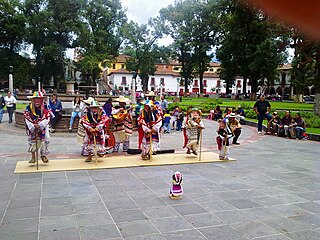 W
W'Danza de los Viejitos' is a traditional folk dance in Michoacán, Mexico.
 W
WThe Danza de los Voladores, or Palo Volador, is an ancient Mesoamerican ceremony/ritual still performed today, albeit in modified form, in isolated pockets in Mexico. It is believed to have originated with the Nahua, Huastec and Otomi peoples in central Mexico, and then spread throughout most of Mesoamerica. The ritual consists of dance and the climbing of a 30-meter pole from which four of the five participants then launch themselves tied with ropes to descend to the ground. The fifth remains on top of the pole, dancing and playing a flute and drum. According to one myth, the ritual was created to ask the gods to end a severe drought. Although the ritual did not originate with the Totonac people, today it is strongly associated with them, especially those in and around Papantla in the Mexican state of Veracruz. The ceremony was named an Intangible cultural heritage by UNESCO in order to help the ritual survive and thrive in the modern world. The Aztecs believed that Danza de los Voladores was the symbol of their culture.
 W
WThe Danza de las tijeras is an original dance of Chanka origin from the south of the Andes, in Peru. The dance consists of two or more dancers, followed by their respective orchestras of a violin and a harp. The dancers dance in turns, doing explicit moves and challenging steps, such as dancing with just one foot.
 W
WA deer dance is any of the world's folk dances performed by people dressed as deer.
 W
WFancy dance, Pan-Indian dancing, Fancy Feather or Fancy War Dance is a style of dance some believe was originally created by members of the Ponca tribe in the 1920s and 1930s, in an attempt to preserve their culture and religion. It is loosely based on the War dance. Fancy dance was considered appropriate to be performed for visitors to reservations and at "Wild West" shows. But today, fancy dancers can be seen at many powwows across the nation and even the world.
 W
WThe Gourd Dance is a social dance.
 W
WThe grass dance or Omaha dance is a style of modern Native American men's pow wow dancing originating in the warrior societies on the Northern Great Plains. Unlike most forms of pow wow dancing, the grass dance regalia generally has no feathers besides the occasional roach feather. The regalia consists of brightly colored fringe made of either yarn, broadcloth, or ribbon.
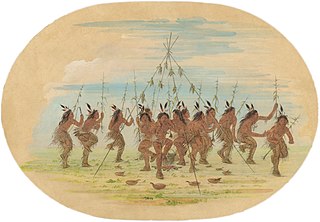 W
WThe Green Corn Ceremony (Busk) is an annual ceremony practiced among various Native American peoples associated with the beginning of the yearly corn harvest. Busk is a term given to the ceremony by white traders, the word being a corruption of the Creek word puskita (pusketv) for "a fast". These ceremonies have been documented ethnographically throughout the North American Eastern Woodlands and Southeastern tribes. Historically, it involved a first fruits rite in which the community would sacrifice the first of the green corn to ensure the rest of the crop would be successful. These Green Corn festivals were practiced widely throughout southern North America by many tribes evidenced in the Mississippian people and throughout the Mississippian Ideological Interaction Sphere. Green Corn festivals are still held today by many different Southeastern Woodland tribes. The Green Corn Ceremony typically occurs in late July–August, determined locally by the ripening of the corn crops. The ceremony is marked with dancing, feasting, fasting and religious observations.
 W
WHuayno is a genre of popular Andean music and dance. It is especially common in Peru, Bolivia, and Argentina, but also present in Chile, and is practiced by a variety of ethnic groups, especially the Quechua people. The history of Huayno dates back to colonial Peru as a combination of traditional rural folk music and popular urban dance music. High-pitched vocals are accompanied by a variety of instruments, including quena (flute), harp, siku (panpipe), accordion, saxophone, charango, lute, violin, guitar, and mandolin. Some elements of huayno originate in the music of the pre-Columbian Andes, especially on the territory of the former Inca Empire. Huayno utilizes a distinctive rhythm in which the first beat is stressed and followed by two short beats.
 W
WInu-Yupiaq is a dance group at the University of Alaska, Fairbanks that performs a fusion of Iñupiaq and Yup’ik Eskimo motion dance.
 W
WThe Kullawada, kullahuada, cullaguada or kullawa is a dance practiced in Bolivia and in the Peruvian highlands. The origin and sense of heritage identity of this dance is disputed. The name of the dance probably derives from the word in Aymara language kullakanakawa("they are sisters" in English) and later due to a clipping it would be renamed kullawa. It is represented both in Bolivia, in the Carnival of Oruro; as in Peru, in the Fiesta de la Candelaria.
 W
WThe Llama llama, also spelled Llamallama or Lama lama, was probably a dance with the characteristics of a farce or a disguise game with acrobatic elements. It is believed that the name of the dance came from the Aymara language, which was the name the Aymara people used to describe the Urus dressed as dancing demons.
 W
WNative American Hoop Dance is one of the individual dances, and it is performed as a show dance in many tribes. It features a solo dancer dancing with a dozen or more hoops and using them to form a variety of both static and dynamic shapes. Most of the hoop dances in tribes across North America belong to modern hoop dance, which was invented in 1930.
 W
WThe Parachico or Parachicos are traditional dancers from Chiapa de Corzo, Chiapas, Mexico, who dance on the streets of the town during the Grand Fiesta festivities, which take place from January 15 to 23 every year. The festival honors the local patron saints the Black Christ of Esquipulas, Saint Anthony Abbot, and Saint Sebastian. It is claimed locally that, like many of the Catholic festivals in Latin America, it has its roots in the much older indigenous culture. So it has developed into a hybrid of old indigenous culture and newer Catholic and Spanish cultures. The church where the festival concludes is home to an old tree which, according to residents, predates the church. This tree is said to represent the "tree of life", which would suggest that this site was used for ceremonies before the arrival of Catholicism.
 W
WQhapaq negro is a traditional dance in the Cusco Region in Peru. It is performed at festivals such as Mamacha Carmen in Paucartambo, celebrating Our Lady of Mount Carmel. and the Festividad de la Virgen del Rosario in the town of Huallhua, San Salvador District, Calca Province, Cusco Department.
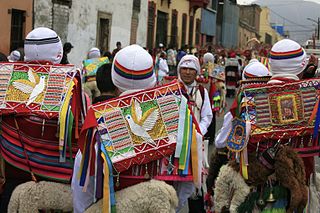 W
WQhapaq Qulla is a folk dance in Peru. It is performed at festivals of the Cusco Region, such as Mamacha Carmen in Paucartambo and the important Quyllur Rit'i at the Winter Solstice on the mountain Qullqipunku.
 W
WRainmaking is a weather modification ritual that attempts to invoke rain.
 W
WSaqra is a traditional dance in the highlands of the Cusco Region in Peru. The dancers dress as animal figures. This traditional dance has its origins in the late 19th century in the province of Paucartambo, Cusco and was inspired by the sacred paintings of the so called “Mamacha Carmen” also known as the "Virgen del Carmen". Saqra means roguery, restlessness, agility or mischief in English.
 W
WShalako is a series of dances and ceremonies conducted by the Zuni people for the Zuni people at the winter solstice, typically following the harvest. The Shalako ceremony and feast has been closed to non-native peoples since 1990. However, non-native peoples may be invited as guests by a Zuni tribal member.
 W
WThe Stomp Dance is performed by various Eastern Woodland tribes and Native American communities, including the Muscogee, Yuchi, Cherokee, Chickasaw, Choctaw, Delaware, Miami, Caddo, Tuscarora, Ottawa, Quapaw, Peoria, Shawnee, Seminole, Natchez, and Seneca-Cayuga tribes. Stomp Dance communities are active in North Carolina, Oklahoma, Alabama, Mississippi, and Florida.
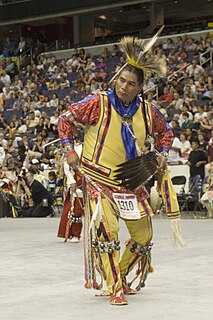 W
WThe Straight Dance, also known as Southern Straight Dance or Southern Traditional, is a style of Native American pow wow dancing. The dance recounts the story of hunting or war parties searching for the enemy.
 W
WThe Sun Dance is a ceremony practiced by some Native Americans and Aboriginal Canadians, primarily those of the Plains cultures. It usually involves the community gathering together to pray for healing. Individuals make personal sacrifices on behalf of the community.
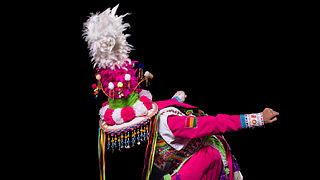 W
WTinku, a Bolivian Aymara tradition, began as a form of ritualistic combat. In the Quechua language, it means “meeting-encounter". During this ritual, men and women from different communities will meet and begin the festivities by dancing. The women will then form circles and begin chanting while the men proceed to fight each other; rarely the women will join in the fighting as well. Large tinkus are held in Potosí during the first few weeks of May.
 W
WTinya palla or wiqru palla is a traditional dance of the Pomabamba Province in the Ancash Region in Peru. In 2009 the National Institute of Culture declared tinya palla a National Cultural Heritage of Peru by Resolución Directoral Nacional No. 491/INC-2009.
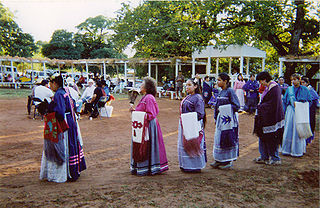 W
WThe turkey dance is one of the most important traditional dances among Caddo people. Women dance the turkey dance, while men drum and sing the songs, which describe events in Caddo history.
 W
WWari is a traditional dance of the Ancash Region in Peru. The dancers are accompanied by musicians who play the tinya and the small pinkuyllu.
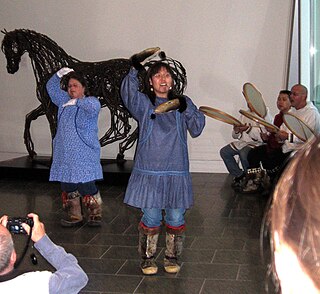 W
WYup'ik dance or Yuraq, also Yuraqing is a traditional Inuit style dancing form usually performed to songs in Yup'ik, with dances choreographed for specific songs which the Yup'ik people of southwestern Alaska. Also known as Cup'ik dance for the Chevak Cup'ik dialect speaking Inuit of Chevak and Cup'ig dance for the Nunivak Cup'ig dialect speaking Inuit of Nunivak Island. Yup'ik dancing is set up in a very specific and cultural format. Typically, the men are in the front, kneeling and the women stand in the back. The drummers are in the very back of the dance group. Dance is the heart of Yup’ik spiritual and social life. Traditional dancing in the qasgiq is a communal activity in Yup’ik tradition. The mask (kegginaquq) was a central element in Yup'ik ceremonial dancing.
 W
WZamba is a traditional dance of Argentina. It is a style of Argentine music and Argentine folk dance. Zamba is very different from its homophone, the samba - musically, rhythmically, temperamentally, in the steps of the dance and in its costume. It has six beats to the bar and is a majestic dance, performed by couples who circle each other waving white handkerchiefs very elegantly. It has common elements with the cueca.